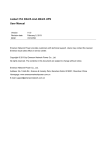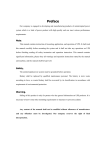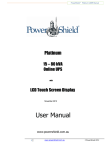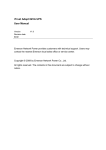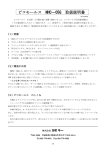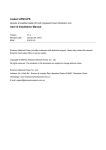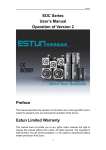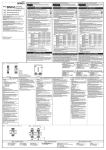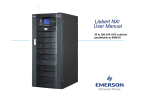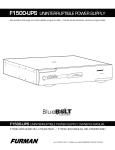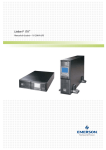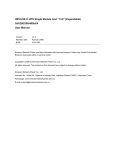Download RM Series Intelligent Modular UPS
Transcript
RM Series Intelligent Modular UPS User and installation Manual Version: V1.0 INVT Power System(Shenzhen) CO., LTD provides full technical supports to customers, who may contact the local office or directly contact the company headquarters. INVT Power System(Shenzhen) CO., LTD All rights reserved. The contents in this document are subject to change without notice. INVT Power System(Shenzhen) CO., LTD Address: Building 4, Longjing Industrial Park, Nanshan District, Shenzhen Postal code: 518055 Website: www.invt-power.com Customer service hotline: 0755-26783295 E-mail: [email protected] Domestic Sales [email protected] Foreign Sales [email protected] Domestic Technical Support [email protected] Foreign Technical Support www.invt-power.com Safety Precautions This manual is about the installation and operation of INVT RM Series modular UPS(Hereinafter referred to as UPS) Please carefully read this manual prior to installation. The UPS must be debugged and maintained by the engineer commissioned by the manufacturer or the agent. Otherwise, human safety may be endangered and the damage of UPS shall not belong to the warranty scope. APPLICABLE STANDARDS This product complies with CE 73/23 & 93/68 (low voltage safety) and 89/336 (EMC) , and EMC standards of Australia and New Zealand (C-Tick) , and the following UPS product standards: *IEC62040-1-1-General and safety requirements for use in operator access area *IEC/EN62040-2 EMC requirements CLASS C3 *IEC62040-3 Performance requirements and test methods WARNING- High earth leakage current Earth connection is critical before connecting the input supply (include both utility supply and battery) . This equipment must be earthed in accordance with local electrical authority codes of practice. Earth leakage current exceeds 3.5 mA and is less than 1000 mA. Transient and steady-state earth leakage currents, which may occur when starting the equipment, should be taken into account when selecting instantaneous RCCB or RCD devices. Residual Current Circuit Breakers ( RCCBs) must be selected insensitive to DC unidirectional pulses ( class A ) and transient current pulses ( RCCBs). Note it that the earth leakage currents of the load will also flow across RCCB or RCD. Components that can be maintained by user All the equipment maintenance and servicing procedures involving internal access need special tools and should be carried out only by trained personnel. The components that can only be accessed by opening the protective cover with tools cannot be maintained by user. This UPS full complies with “IEC62040-1-1-General and safety requirements for use in operator access area. UPS dangerous voltages are present within the battery box. However, the risk of contact with these high voltages is minimized for non-service personnel. Since the component with dangerous voltage can only be touched by opening the protective cover with a tool, the possibility of touching high voltage component is minimized. No risk exists to any personnel when operating the equipment in the normal manner, following the recommended operating procedures in this manual. Battery Voltage Higher Than 400Vdc All the battery maintenance and servicing procedures involving internal access need special tools or keys and should be carried out only by trained personnel. SPECIAL CARE SHOULD BE TAKEN WHEN WORKING WITH THE BATTERIES ASSOCIATED WITH THIS EQUIPMENT. WHEN CONNECTED TOGETHER, THE BATTERY TERMINAL VOLTAGE WILL EXCEED 400Vdc AND IS POTENTIALLY LETHAL. Battery manufacturers supply details of the necessary precautions to be observed when working on, or in the vicinity of, a large bank of battery cells. These precautions should be followed implicitly at all times. Particular attention should be paid to the recommendations concerning local environmental conditions and the provision of protective clothing, first aid and fire-fighting facilities. www.invt-power.com Contents Chapter 1 Installation ..............................................................................................................................................................................1 1.1 Introduction ..............................................................................................................................................................................1 1.2 Initial Checking ........................................................................................................................................................................1 1.3 Positioning................................................................................................................................................................................1 1.3.1 Distribution Room........................................................................................................................................................1 1.3.2 Battery Room ...............................................................................................................................................................2 1.3.3 Storing..........................................................................................................................................................................2 1.4 Disassembly, Initial Checking and Positioning ........................................................................................................................2 1.4.1 System Packaging: .......................................................................................................................................................2 1.4.2 Module Packaging:.......................................................................................................................................................4 1.4.3 UPS Composition.........................................................................................................................................................1 1.4.4 Operation Space ...........................................................................................................................................................2 1.4.5 Front and Back Access.................................................................................................................................................2 1.4.6 Final Positioning ..........................................................................................................................................................2 1.4.7 Power Module Installation ...........................................................................................................................................2 1.4.8 Cable Entry ..................................................................................................................................................................3 1.5 Protective Devices....................................................................................................................................................................3 1.5.1 Rectifier and Bypass Input Supply of the UPS.............................................................................................................3 1.5.2 Battery..........................................................................................................................................................................4 1.5.3 UPS Output ..................................................................................................................................................................4 1.6 Power Cables............................................................................................................................................................................4 1.6.1 Maximum stable state current and configuration of cable system, please refer to table 1-2.........................................4 1.6.2 Cable Connection .........................................................................................................................................................5 1.7 Control and Communication Cabling.......................................................................................................................................6 1.7.1 Dry Contact Interface of Battery and Environmental Temperature Detection .............................................................6 1.7.2 Remote EPO Input Port................................................................................................................................................7 1.7.3 Generator Input Dry Contact........................................................................................................................................7 1.7.4 BCB Input Port.............................................................................................................................................................8 1.7.5 Battery Warning Output Dry Contact Interface............................................................................................................8 1.7.6 Integrated Warning Output Dry Contact Interface .......................................................................................................9 1.7.7 Mains Failure Warning Output Dry Contact Interface .................................................................................................9 1.7.8 RS232 Port and SNMP Card Port ...........................................................................................................................10 1.7.9 LBS (Load Bus Synchronizer) Port.........................................................................................................................10 1.8 Installation Drawing ...............................................................................................................................................................10 Chapter 2 Operations.............................................................................................................................................................................15 2.1 Introduction ............................................................................................................................................................................15 2.1.1 Principle .....................................................................................................................................................................15 2.1.2 Bypass Module...........................................................................................................................................................16 www.invt-power.com 2.2 Operation Mode......................................................................................................................................................................16 2.2.1 Normal Mode .............................................................................................................................................................17 2.2.2 Battery Mode..............................................................................................................................................................17 2.2.3 Auto-Restart Mode.....................................................................................................................................................17 2.2.4 Bypass Mode..............................................................................................................................................................17 2.2.5 Maintenance Mode.....................................................................................................................................................17 2.2.6 ECO Mode .................................................................................................................................................................17 2.2.7 Frequency Converters Mode ......................................................................................................................................17 2.3 Battery Management ..............................................................................................................................................................18 2.3.1 Normal Function ........................................................................................................................................................18 2.3.2 Advanced Functions (Battery Self-checking and Maintenance).................................................................................18 2.4 Battery Protection...................................................................................................................................................................18 Chapter 3 Operating Steps.....................................................................................................................................................................19 3.1 Power Switches ......................................................................................................................................................................19 3.2 UPS Start-up...........................................................................................................................................................................19 3.2.1 Normal Module Start..................................................................................................................................................19 3.3 Procedure for Switching between Operation Modes ..............................................................................................................22 3.3.1 Procedure for Switching the UPS into Battery from Normal Mode ...........................................................................22 3.3.2 Procedure for Switching the UPS into Bypass from Normal Mode ...........................................................................22 3.3.3 Procedure for Switching the UPS into Normal from Bypass Mode ...........................................................................22 3.3.4 Procedure for Switching the UPS into a Maintenance Bypass from Normal Mode ...................................................22 3.3.5 Procedure for Switching the UPS into Normal from a Maintenance Bypass Mode ...................................................22 3.4 Procedure for Completely Powering down a UPS..................................................................................................................23 3.5 EPO Procedure .......................................................................................................................................................................23 3.6 Language Selection ................................................................................................................................................................23 3.7 Control Password ...................................................................................................................................................................23 Chapter 4 Operator Control and Display Panel .....................................................................................................................................24 4.1 Introduction ............................................................................................................................................................................24 4.1.1 LED Indicator ............................................................................................................................................................25 4.1.2 Audible Alarm (buzzer) .............................................................................................................................................25 4.1.3 Functional Keys .........................................................................................................................................................25 4.2 LCD Display Type .................................................................................................................................................................26 4.3 Detailed Description of Menu Items.......................................................................................................................................28 4.4 Alarm List ..............................................................................................................................................................................30 Chapter 5 Maintenance..........................................................................................................................................................................32 5.1 Instruction to Power, Bypass, and Output Power Distribution Module..................................................................................32 5.1.1 Precautions .................................................................................................................................................................32 5.1.2 Instruction to Power Module......................................................................................................................................32 5.1.3 Instruction to Bypass Module.....................................................................................................................................32 5.2 Replacing Dust Screen (option)..............................................................................................................................................33 www.invt-power.com Chapter 6 Product Specification ............................................................................................................................................................34 6.1 Applicable Standards..............................................................................................................................................................34 6.2 Environmental Characteristics................................................................................................................................................34 6.3 Mechanical Characteristics.....................................................................................................................................................34 6.4 Electrical Characteristics (Input Rectifier) .............................................................................................................................35 6.5 Electrical Characteristics (Intermediate DC Link)...............................................................................................................35 6.6 Electrical Characteristics (Inverter Output)............................................................................................................................36 6.7 Electrical Characteristics(Bypass Mains Input)......................................................................................................................37 6.8 Efficiency ...............................................................................................................................................................................37 Appendix 1 A Guidebook to Ordering and Selection of PM System..............................................................................................38 www.invt-power.com Chapter 1 Installation 1 Chapter 1 Installation This chapter introduces the installation of RM series UPS(hereby referred to as UPS), including initial checking, sitting, positioning, cabling and installation drawings. 1.1 Introduction This chapter introduces the relevant requirements for positioning and cabling of the UPS. As each site has its requirements, this chapter provides step-by-step installation instructions, which acts as a guide to the general procedures and practices that should be observed by the installing engineer. Warning-Installation can only be done by authorized engineers 1. Do not apply electrical power to the UPS equipment before the approval of commissioning engineer. 2. The UPS should be installed by a qualified engineer in accordance with the information contained in this chapter. Note: 3-Phase 4-Wire Input Power is required The standard UPS can be connected to TN, TT and IT AC distribution system (IEC60364-3) of 3-phase 5-wire WARNING: battery hazards SPECIAL CARE SHOULD BE TAKEN WHEN WORKING WITH THE BATTERIES ASSOCIATED WITH THIS EQUIPMENT. When connecting the battery, the battery terminal voltage will exceed 400Vdc and is potentially lethal. Eye protection should be worn to prevent injury from accidental electrical arcs. z Remove rings, watches and all metal objects. z Only use tools with insulated handles. z Wear rubber gloves. z If a battery leaks electrolyte, or is otherwise physically damaged, it must be replaced, stored in a container resistant to sulfuric acid and z disposed of in accordance with local regulations. If electrolyte comes into contact with the skin, the affected area should be washed immediately with water. z 1.2 Initial Checking Perform the following checking operations prior to the UPS installation. 1. Visually examine if there is any damage inside and outside the UPS rack and battery equipment due to the transportation. Report any such damage to the shipper immediately. 2. Verify the product label and confirm the correctness of the equipment. The equipment label is attached on the back of front door. The UPS model, capacity and main parameters are marked on the label. 1.3 Positioning 1.3.1 Distribution Room The UPS is designed for indoor installation, which shall be located in a clean environment with adequate ventilation to keep the environmental temperature within the required specification. The UPS uses forced convection cooling by internal fans. Cooling air enters the module through ventilation grills located at the front part of the cabinet and exhausted through grills located in the rear part of the cabinet. Please do not block the ventilation holes. RM Series Modular UPS User and Installation Manual 1 2 Chapter 1 Installation If necessary, a system of extractor fans should be installed to aid cooling-air flow. An air filter should be used when the UPS is to operate in a dirty environment and should be regularly cleaned to maintain airflow. Note: The UPS should be installed on a cement surface or other surface that is not combustible. 1.3.2 Battery Room The battery will generate some amount of hydrogen and oxygen at the end of charging, so the fresh air volume of the battery installation environment must meet EN50272-2001 requirements. The ambient temperature of the battery must be stable. Ambient temperature is a major factor in determining the battery capacity and life. The nominal operating temperature of battery is 20°C. Operating above this temperature will reduce the battery life, and operation below this temperature will reduce the battery capacity. If the average operating temperature of battery is increased from 20ºC to 30ºC, then the service life of the battery will be reduced by 50%. If the operating temperature of the battery is above 40ºC, then the battery service life will be decreased in exponent rate. In a normal installation, the battery temperature is maintained between 15°C and 25°C. Keep batteries away from heat sources or air outlets. If external batteries are to be used, a battery protection device (a DC circuit breaker) must be mounted as close as possible to the batteries, and the connecting cables should be as short as possible. 1.3.3 Storing If the equipment is not installed immediately, it must be stored in a room so as to protect it against excessive humidity and heat sources. The battery needs to be stored in dry and cool place with good ventilation. The most suitable storage temperature is 20 ºC to 25ºC. 1.4 Disassembly, Initial Checking and Positioning Check the packaging first upon the arrival of product to see if there is any damage; open the packaging to check the equipment; report any such damage to the shipper immediately. 1.4.1 System Packaging: Open the wooden case first, the open method is shown in fig 1-1: Fig 1-1 Open method RM Series Modular UPS User and Installation Manual 2 Chapter 1 Installation 3 Firstly, open the top plate of the steel-edged wooden case with slotted awl and plier, followed by sideboards. Be careful not to scratch the product. See fig 1-2. Fig 1-2 Disassemble the case Take out the foam after disassembling the sideboards of the case as shown in fig 1-3. Fig 1-3 Complete the disassembly Tip: Dismantle the bolt that connects the cabinet and wooden pallet after disassembly, then lift the cabinet to installation position. The dismantlement should be careful so as not to scratch the body. Verify the product label and confirm the correctness of the equipment. The equipment label is attached on the back of front door. The UPS model, capacity and main parameters are marked on the label. RM Series Modular UPS User and Installation Manual 3 4 Chapter 1 Installation 1.4.2 Module Packaging: The open method is shown in fig 1-4: The packing case should be placed horizontal and stable; Fig 1-4 Open method Cut the plastic packing belt and scotch tape to open the carton, see fig 1-5: Foamed package Carton Fig 1-5 Open the carton Open the foamed cover, the equipment with plastic package can be see as shown in fig 1-6: RM Series Modular UPS User and Installation Manual 4 Chapter 1 Installation 5 Top cover of foamed package Carton Foamed package Equipment Fig 1-6 Open the foamed cover At last, take out the equipment with plastic package, and dismantle the packaging materials. Warm Tips: Please dispose the wasted materials in accordance with environmental protection requirements after disassembly. To prolong the service life, the place chosen for the UPS must guarantee: z Easy wiring z Sufficient space for operation z Air sufficient enough to dispel heat produced by UPS z Against ambient corrosive gases z Against excessive humidity and heat sources z Against dust z With the current fire prevention requirements z The operating environment temperature is within 20℃~25℃. The batteries are at maximum efficiency in this temperature range (for information about the battery storage and transportation as well as the environment, please refer to table 6-2) RM Series Modular UPS User and Installation Manual 5 Chapter 1 Installation 1.4.3 UPS Composition UPS composition shall refer to fig 1-7, UPS configuration shall refer to table 1-1. Switch unit 开关单元 switch unit 配电单元 Distribution unit Bypass module 旁路模块 功率模块 Power module 2m cabinet (front view) 2m cabinet (back view) Switch unit 开关单元 配电单元 Distribution unit 旁路模块 Bypass module Power module 功率模块 1.6m cabinet (front view) 1.6m cabinet (back view) Fig 1-7 UPS Composition Diagram RM Series Modular UPS User and Installation Manual 1 1 2 Chapter 1 Installation Table 1-1 UPS Configuration Table Cabinet Power module Involved part name Quantity (Piece) Note Switch PDU 1 Standard configuration Monitoring + bypass module 1 Standard configuration Power module 1~6 or 1~10 Field installation is required 1.4.4 Operation Space As UPS has no ventilation grills at either sides, no clearances are required for the sides. To enable routine tightening of power terminations within the cabinet, it is recommended that clearance around the front and back of the equipment should be sufficient to enable free passage of personnel with the doors fully opened. 1.4.5 Front and Back Access The component layout of the UPS supports front and back access for servicing, diagnosing and repairing the UPS, thus reducing the space requirement for side access. 1.4.6 Final Positioning When the equipment has been finally positioned, ensure the adjustable feet are set so that the UPS will remain stationary and stable. 1.4.7 Power Module Installation The installation position of power module and output distribution module are shown in fig 1-8. the installation principle of these module is to installed from bottom to top to prevent inclination of the cabinet due to high center of gravity . As is shown in fig 1-8, the installation procedure of power module is as follows: 1. Each module shall be installed from bottom to top, the default setting of the system is module No. 1, 2, 3, 4, 5, 6, 7, 8, 9, and 10. 2. Insert the module into installation position, and push in the cabinet. The wiring terminals in between shall be tight, and excessive force shall be prevented against the damage to inserted pins of the terminals. 3. Fix the module to the cabinet though the mounting holes on two sides of the front plate of the module. 固定孔 Fixing hole Power module Amplification A处放大 of A Fig 1-8 Power Module Installation Diagram RM Series Modular UPS User and Installation Manual 2 Chapter 1 Installation 3 1.4.8 Cable Entry Cables can enter the UPS from top and below as shown in fig 1-9. Both the top and bottom of the UPS have cable entrance. The recommended installation practice is to install power cables in the entrance channel at both sides of the cabinet back door, so as not to affect the ventilation. 进线通道 Cable entrance 进线通道 Cable entrance Fig 1-9 Cable Entry Diagram 1.5 Protective Devices For safety concerns, it is recommended to install external circuit breakers or other protective devices for the input AC supply of the UPS system. This section provides generic practical information for qualified installation engineers. The installation engineers should have the knowledge of the regulatory wiring standards, and of the equipment to be installed. 1.5.1 Rectifier and Bypass Input Supply of the UPS Install suitable protective devices in the distribution unit of the incoming mains supply, considering the power cable current-carrying capacity and overload capacity of the system (see Table 1).Generally, the magnetic circuit breaker with IEC60947-2 tripping curve C (normal) at the 125% of the current listed in table 1-1 is recommended. Note For IT power network system, 4-pole protective device must be installed on the external input distribution of the UPS. If protection against earth faults (RCD devices) is required for the upstream of the input supply, the installed device should: z Sensitive to DC unidirectional pulses (class A) in the network z Insensitive to transient current pulses z Have an average sensitivity that is adjustable between 0.3A~1A The RCCB must be sensitive to DC unidirectional pulses (class A) in the network, while insensitive to transient current pulses, as shown in fig 1-10 respectively. RM Series Modular UPS User and Installation Manual 3 4 Chapter 1 Installation Fig 1-10 RCCB sign 1.5.2 Battery A battery unit is composed of 40 batteries connected in series, a centreline is drawn from in between (the joint part between the 20th and 21st battery), plus the line drawn from the front and back, there are altogether 3 lines connected with UPS line contact bank. The battery line must push through a DC circuit breaker before connecting to corresponding UPS line contact bank. The detailed wiring please refer to fig 1-11 below: 40 batteries connected in series Fig 1-11 Diagram of batteries connected in series 1.5.3 UPS Output A main output switch has been installed in UPS, the user shall install the over current protective device on the bypass of each output of the external distribution cabinet. 1.6 Power Cables Design the cables according to the descriptions in this section and local regulatory wiring standards, and the environmental conditions should be taken into consideration. Refer to IEC60950-1 Table 3B. Warning Prior to cabling the UPS, confirm the status and positions of the switches of the UPS rectifier input power supply / bypass power supply and mains power distribution board. Ensure that these switches are opened and attached with WARNING label so as to prevent unauthorized operation to these switches. 1.6.1 Maximum stable state current and configuration of cable system, please refer to table 1-2. RM Series Modular UPS User and Installation Manual 4 Chapter 1 Installation 5 Table 1-2 Maximum stable state current and configuration of cable system System Name Capacity RM-060/10 RM-090/15 System capacity 60kVA 90kVA Module capacity 10kVA 15kVA Cabinet dimension Main Input Output Battery PE RM-120/20 RM-100/10 RM-150/15 120kVA 100kVA 150kVA 200kVA 20kVA 10kVA 15kVA 20kVA 600*900*1600(W*D*H mm) RM-200/20 600*900*2000(W*D*H mm) Rated current A 90 136 180 150 227 300 Cable mm2 25 35 50 50 75 75 Rated current A 90 136 180 150 227 300 Cable mm2 25 35 50 50 75 75 Rated current A 106 160 212 178 265 355 Cable mm2 35 50 75 50 75 90 2 35 50 75 50 75 90 Cable mm Warning FAILURE TO FOLLOW ADEQUATE EARTHING PROCEDURES CAN RESULT IN EMI, ELECTRIC SHOCK HAZARD OR RISK OF FIRE. 1.6.2 Cable Connection Note The operations described in this section must be performed by authorized electricians or qualified technical personnel.. If you have any difficulties, do not hesitate to contact our Customer Service & Support department at the address given at the beginning of this manual. After the equipment has been finally positioned and secured, connect the power cables as described in the following procedures: 1. Verify that all the external input distribution switches of the UPS are completely opened and the UPS internal maintenance bypass switch is opened. Attach necessary warning signs to these switches to prevent unauthorized operation. 2. Open the back door of the cabinet, remove the cover and then the input and output terminal, battery terminal and earth terminal are visible.. 3. Connect the input earth wire to input earth terminal. Please note: the earth wire shall be connected in accordance with related local or state regulation 4. For common bypass and rectifier inputs, connect the AC input supply cables to the UPS input terminals (Main input A-B-C-N), and connect the output loaded cable to the UPS output terminals (Output A-B-C-N) and tighten the connections to 13 Nm (M8 Bolt). ENSURE CORRECT PHASE ROTATION. 5. Connect the battery cables between the UPS battery terminals and battery switch. ENSURE CORRECT PHASE ROTATION. Warning-Hazardous battery terminal voltage of 400Vdc Ensure the correct polarity connection between the battery terminals and the UPS terminals: Positive terminal to positive terminal, negative terminal to negative terminal, and disconnect one or more than one cable between every two layers of batteries. Do not connect the cables and close the battery circuit breakers before getting the approval from the commissioning engineer. RM Series Modular UPS User and Installation Manual 5 6 Chapter 1 Installation 6. Re-install all the protective covers. 1.7 Control and Communication Cabling As shown in fig 1-12, the front panel of the bypass module will provide dry contact interface (J2~J10), communication interface (RS232, 485 and SNMP card interface), as well as LBS interface. SNMP card port SNMP卡接口 Dry contact 干接点接口 interface RS232 port RS232接口 LBS接口 LBS port RS485 port RS485接口 Fig 1-12 Dry contact interface and communication interface The UPS accepts external signal from zero-voltage (dry) contacts connected through external dry contact terminals produced and phoenix terminals that are in bypass module. Through software programming, these signals become active when these contacts connect to +24V to ground).The cables connected to DRY terminal must be separated from power cables. Moreover, these cables should be double insulated with a typical 0.5 to 1.5 mm2 cross-section area for a maximum connection length between 25 and 50 meters. 1.7.1 Dry Contact Interface of Battery and Environmental Temperature Detection The input dry contact J2 and J3 can detect the temperature of batteries and environment respectively, which can be used in environment monitoring and battery temperature compensation 1. J2 and J3 interfaces diagram are shown in fig 1-13, the description of interface is in table 1-3. Fig 1-13 Diagram of J2 and J3 dry contact for temperature detecting Table 1-3 Description of input dry contact interface J2 and J3 Position Name J2.1 J2.2 TEMP_BAT GND J3.1 TEMP_ENV J3.2 GND RM Series Modular UPS User and Installation Manual Purpose Battery temperature detection Power ground Environment temperature detection Power ground 6 Chapter 1 Installation Position Name J2.1 J2.2 TEMP_BAT GND Battery temperature detection Power ground J3.1 TEMP_ENV Environment temperature detection 7 Purpose Note: 1. Specified temperature sensor is required for temperature detection (R25=5Ohm, B25/50=3275), please confirm with the manufacturer, or contact local maintenance engineers when placing an order. 1.7.2 Remote EPO Input Port The UPS has an Emergency Power OFF (EPO) function. This function can be activated by pressing a button on the control panel of the UPS or through a remote contact provided by the user. The EPO pushbutton is protected by a hinged plastic cover. J4 is the input port for remote EPO. It requires shorting NC and +24v during normal operation, and the EPO is triggered when opening NC and +24v, or shorting NO and +24v. The port diagram is shown in fig 1-14, and port description is shown in table 1-4. Fig 1-14 Diagram of input port for remote EPO Table 1-4 Description of input port for remote EPO Position Name Purpose J4.1 EPO_NC EPO is activated when disconnecting fromJ4.2 J4.2 +12V +24V, connect the common terminal of NC and NO J4.3 +12V EPO is activated when shorting with J4.2 The EPO is triggered when shorting pin 2 and 3 or opening pin 2 and 1 of J4. If an external emergency stop facility is required, it is connected via the reserved terminals of J10.The external emergency stop facility needs to use shielded cables to connect to the normally open/closed remote stop switch between these two pins. If this facility is not used, then pin 3 and pin 4 of J4 must be open, or pin 1 and pin 2 of J4 must be shorted. Note 1. The emergency stop action within the UPS will shut down the rectifier, inverter and static bypass. However, it does not internally disconnect the mains input power supply. To disconnect ALL power to the UPS, open the upstream input circuit breaker(s) when the EPO is activated. 2. Pin 1 and 2 of J4 have been shorted before the UPS is delivered 1.7.3 Generator Input Dry Contact J5 is status interface for generator connection. Connect pin 2 of J5 with + 24 power supply, it indicates that the generator has been connected with the system. The interface diagram is shown in fig 1-15, and interface description is shown in table 1-5. RM Series Modular UPS User and Installation Manual 7 8 Chapter 1 Installation Generator Fig 1-15 Diagram of status interface and connection of generator Table 1-5 Description of maintenance bypass switch and output switch status interface Position Name J5.1 +24V +24V power supply Purpose J5.2 GEN Connection status of generator J5.3 GND Power ground 1.7.4 BCB Input Port J6 and J7 are the ports of BCB. The port diagram is shown in fig 1-16, and description is shown in table 1-6. +24V +24V +24V BCB_CONT BCB_DRV BCB_ONL J7 J6 Fig 1-16 BCB Port Table 1-6 Description of BCB port Position Name J6.1 BCB_DRV J6.2 BCB_CONT J7.1 J7.2 GND BCB_ONL Description BCB actuating signal, provide the actuating signal of +18V, 20mA BCB contact status, connect with the normally open signal of BCB Power ground BCB on-line–input (normally open) , BCB is on-line when the signal is connecting with GND 1.7.5 Battery Warning Output Dry Contact Interface J8 is the output dry contact interface, which outputs the battery warnings of low or excessive voltage, when the battery voltage is lower than set value, an auxiliary dry contact signal will be provided via the isolation of a relay. The interface diagram is shown in fig 1-17, and description is shown in table 1-7. RM Series Modular UPS User and Installation Manual 8 Chapter 1 Installation 9 Fig 1-17 Battery warning dry contact interface diagram Table 1-8 Battery warning dry contact interface description Position Name J8.1 BAT_LOW_NC Battery warning relay (normally closed) will be open during warning Purpose J8.2 BAT_LOW_NO Battery warning relay (normally open) will be closed during warning J8.3 GND Center of battery warning relay 1.7.6 Integrated Warning Output Dry Contact Interface J9 is the integrated warning output dry contact interface, when one or more than one preset warning is triggered, the system will send an integrated warning information, and provide an auxiliary dry contact signal via the isolation of a relay. The interface diagram is shown in fig 1-18, and description is shown in table 1-8. Fig 1-18 Integrated warning dry contact interface diagram Table 1-8 Integrated warning dry contact interface description Position Name J9.1 ALARM_NC Integrated warning relay (normally closed) will be open during warning Purpose J9.2 J9.3 ALARM_NO GND Integrated warning relay (normally open) will be closed during warning Centre of integrated warning relay 1.7.7 Mains Failure Warning Output Dry Contact Interface J10 is the output dry contact interface for mains failure warning, when the mains fails, the system will send a mains failure warning information, and provide an auxiliary dry contact signal via the isolation of a relay. The interface diagram is shown in fig 1-19, and description is shown in table 1-9. RM Series Modular UPS User and Installation Manual 9 10 Chapter 1 Installation Fig 1-19 Mains failure warning dry contact interface diagram Table 1-9 Mains failure warning dry contact interface description 1.7.8 Position Name J9.1 UTI_FAIL_NC Purpose J9.2 UTI_FAIL_NO J9.3 GND Mains failure warning relay(normally closed) will be open during warning Mains failure warning relay normally open) will be closed during warning Centre of mains failure warning relay RS232 Port and SNMP Card Port RS232 and RS485 Port: provide serial data which can be used for commissioning and maintenance by authorized engineers or maintainers, or can be used for networking or integrated monitoring system in the service room. SNMP Card Port: used for field installation of the communication option card(SNMP card). 1.7.9 LBS (Load Bus Synchronizer) Port The dual bus system (DBS) consists of two independent UPS rack module systems, as shown in fig 1-20. The dual bus system is configured for high availability and is suitable for powering the load with dual inputs. If the load is single-input load, the static transfer switch and LBS control is recommended to maintain both UPS outputs synchronized for uninterrupted transfers. Please install the system according to the installation descriptions for different system configurations. The dual bus system is supported by UPS, it requires connecting the LBS signal cables of two UPS when constructing the dual bus system; please refer to relevant chapter for detailed configuration and installation, and the system software shall be configured as required. 1 监控旁路模块 UPS 1UPS monitoring bypass module 2 监控旁路模块 UPSUPS 2 monitoring bypass module LBS LBS Fig 1-20 LBS Connection Diagram 1.8 Installation Drawing Please refer to fig 1-21, fig 1-22, fig 1-23 and fig 1-24: RM Series Modular UPS User and Installation Manual 10 Chapter 1 Installation 11 RM series SNMP card PE ground Input Power cable Output Dry contact Battery Fig 1-21 Installation Diagram RM Series Modular UPS User and Installation Manual 11 12 Chapter 1 Installation 顶视图 Top view 2m cabinet front view Fig 1-22 UPS front view (Unit: mm) RM Series Modular UPS User and Installation Manual 12 Chapter 1 Installation 1.6 m cabinet (front view) A Input terminal 电池端子 Output terminal 输入端子 Battery terminal A 接地端子 Ground terminal 输出端子 A处放大 Amplification of A 2m cabinet A Ground terminal 接地端子 Output terminal Iinput 输入端子 输出端子 terminal Amplification of A A处放大 1.6m cabinet Fig 1-23 UPS back view RM Series Modular UPS User and Installation Manual 13 Battery 电池端子 terminal 13 14 Chapter 1 Installation A A处放大 Amplification of A Fig 1-24 UPS front view RM Series Modular UPS User and Installation Manual 14 Chapter 2 Operations 15 Chapter 2 Operations This chapter introduces the basic knowledge of UPS operations, including working principle, operation mode, battery management and protection. Warning: Hazardous mains voltage and/or battery voltage present(s)behind the protective cover The components that can only be accessed by opening the protective cover with tools cannot be operated by user. Only qualified service personnel are authorized to remove such covers. 2.1 Introduction UPS provides the critical load (such as communication and data processing equipment) with high quality uninterruptible AC power. The power from UPS is free from voltage and frequency variations and disturbances (interruption and spike) experienced at the Mains AC input supply. This is achieved through high frequency double conversion power pulse width modulation (PWM) associated with full digital signal processing control (DSP), which features high reliability and convenience for use. 2.1.1 Principle As shown in fig 2-1, the AC input mains source is supplied at UPS input and converted into a DC source. This DC source feeds the Inverter that converts the DC source into a clean and input independent AC source. The battery powers the load through the inverter in case of an AC input mains power failure. The utility source can also power the load through the static bypass. When the UPS needs maintenance or repair, the load can be transferred to maintenance bypass without interruption and the power module and bypass module can be removed for maintenance. RM Series Modular UPS User and Installation Manual 15 16 Chapter 2 Operations Maintenance bypass switch Q2 Monitoring bypass module Input power System output UPS module UPS module UPS module External battery switch Battery group Fig 2-1System principle framework 2.1.2 Bypass Module The circuit blocks labeled “bypass module” in fig 2-1 contain electronically controlled switching circuits that enable the critical load to be connected to either the inverter output or to a bypass power source via the static bypass line. During normal system operation the load is connected to the inverter; but in the event of a UPS overload or inverter failure, the load is automatically transferred to the static bypass line. To provide a clean (no-break) load transfer between the inverter output and static bypass line, the inverter output and bypass supply must be fully synchronized during normal operating conditions. This is achieved through the inverter control electronics, which makes the inverter frequency track that of the static bypass supply, provided that the bypass remains within an acceptable frequency window. A manually controlled maintenance bypass supply is incorporated into the UPS design. It enables the critical load to be powered from the utility (bypass) supply while the UPS is shut down for routine maintenance. Note When the UPS is operating in bypass mode or on maintenance bypass, the connected equipment is not protected from power failures or surges and sags. 2.2 Operation Mode The RM UPS is an on-line, double-conversion, reverse-transfer UPS that permits operation in these modes:: z Normal mode z Battery mode z Auto-Restart mode z Bypass mode z Maintenance mode (manual bypass) RM Series Modular UPS User and Installation Manual 16 Chapter 2 Operations 17 z ECO mode z Frequency converters mode 2.2.1 Normal Mode The UPS inverter power modules continuously supplies the critical AC load. The rectifier/charger derives power from the AC mains input source and supplies DC power to the inverter while simultaneously FLOAT or BOOST charging its associated backup battery. 2.2.2 Battery Mode Upon failure of the AC mains input power; the inverter power modules, which obtains power from the battery, supplies the critical AC load. There is no interruption in power to the critical load upon failure. After restoration of the AC mains input power, the “Normal Mode” operation will continue automatically without the necessity of user intervention. Note: UPS can also be started through battery (charged) mode via battery cold start function upon failure of the AC mains. Therefore, the battery power can be used independently to improve the utilization rate of UPS. 2.2.3 Auto-Restart Mode The battery may become exhausted following an extended AC mains failure. The inverter shuts down when the battery reaches the End of Discharge voltage (EOD). The UPS may be programmed to “Auto Recovery after EOD” after a delay time if the AC mains recovers. This mode and any delay time are programmed by the commissioning engineer. During the process of delay time, the battery will be charged by UPS to prevent any risks to load equipment from future mains failure. 2.2.4 Bypass Mode If the inverter overload capacity is exceeded under normal mode, or if the inverter becomes unavailable for any reason, the static transfer switch will perform a transfer of the load from the inverter to the bypass source, with no interruption in power to the critical AC load. 2.2.5 Maintenance Mode A manual bypass switch is available to ensure continuity of supply to the critical load when the UPS becomes unavailable e.g. during a maintenance procedure. Note: This manual bypass switch is fitted in all UPS modules. Transfer UPS system to bypass module for power supply first, then close maintenance bypass switch Q2, followed by Q1 and Q3. Warning: hazard may occur after transferring to maintenance bypass After UPS being transferred to maintenance bypass, power module and bypass module do not work, no display on LCD, and input and output terminals as well as N bus are electrically connected. 2.2.6 ECO Mode If economical (ECO) mode is selected, the double-conversion UPS will stop to work so as to save energy. During the operation of ECO mode, the load power will be supplied by bypass preferentially. When bypass power is within the range of normal frequency and voltage, load power will be supplied by bypass, or the system will transfer to inverter input, followed by load power interruption which extends within 3/4 of the utility period. E.g. when the frequency is 50Hz, the interruption time will be less than 15ms; when the frequency is 60Hz, the time will be less than 12.5ms. 2.2.7 Frequency Converters Mode If the frequency converter configuration is used by UPS, it will provide 50Hz or 60Hz stable output frequency. The range of output frequency is 40Hz~70Hz. Under this mode, static bypass is unavailable, but battery can be selected according to the actual requirements of battery mode. RM Series Modular UPS User and Installation Manual 17 18 Chapter 2 Operations 2.3 Battery Management 2.3.1 Normal Function The following functions should be fitted by commissioning engineers with specified software. 1. Constant current boost charging Current can be set up. 2. Constant voltage boost charging Voltage of boost charging can be set as required by the type of battery. For Valve Regulated Lead Acid (VRLA) batteries, maximum boost charge voltage should not exceed 2.4V / cell. 3. Float charge Voltage of float charging can be set as required by the type of battery. For VRLA, float charge voltage should be between 2.2V to 2.3V. 4. Float charge temperature compensation (optional) A coefficient of temperature compensation can be set as required by the type of battery. 5. End of discharge (EOD) protection If the battery voltage is lower than the EOD, the battery converter will shut down and the battery is isolated to avoid further battery discharge. EOD is adjustable from 1.6V to 1.75V per cell (VRLA) or 0.9 to 1.1 V per cell 6. Battery low warning time It is adjustable between 3 and 60 minutes. The default is 5 minutes. 2.3.2 Advanced Functions (Battery Self-checking and Maintenance) At periodic intervals, 20% of the rated capacity of the battery will be discharged automatically, and the actual load must exceed 20% of the rated UPS (KVA) capacity. If the load is less than 20%, auto-discharge cannot be executed. The periodic interval can be set from 30 to 360 days. The battery self-test can be disabled. Conditions—Battery at float charge for at least 5 hours, load equal to 20~100% of rated UPS capacity Trigger—Manually through the command of “Battery Maintenance Test” in LCD panel or automatically Battery Self-Test Interval—30-360 days (default setting is battery self-test disabled). 2.4 Battery Protection The following functions should be fitted by commissioning engineers with specified software. 1. Battery Low Pre-warning The battery under voltage pre-warning occurs before the end of discharge. After this pre-warning, the battery should have the capacity for 3 remaining minutes discharging with full load. The time is user configured from 3 to 60 minutes. 2. Battery discharge (EOD)off protection If the battery voltage is lower than the EOD, the battery converter will be shut down. EOD is adjustable from 1.6V to 1.75V per cell (VRLA) or 0.9 to 1.1 V per cell (NiCd) 3. Battery Circuit Breaker (BCB) Alarm The alarm occurs when the battery disconnect device disconnects. The external battery connects to the UPS through the external battery circuit breaker. The circuit breaker is manually closed and tripped by the UPS control circuit. RM Series Modular UPS User and Installation Manual 18 Chapter 3 Operation Instructions 19 Chapter 3 Operating Steps This chapter describes UPS operation instructions in detail. All functional keys and LED display involved in operation instructions please refer to chapter 4. During operation, the buzzer alarm may occur at any time. Select “mute” on LED to muffle the audible alarm. Warning-Hazardous mains voltage and/or battery voltage present(s)behind the protective cover 1. The components that can only be accessed by opening the protective cover with tools cannot be operated by user. 2. Only qualified service personnel are authorized to remove such covers. 3.1 Power Switches As shown in fig 3-1, open the front door of UPS, the power switch is visible, which includes: input switch, output switch and maintenance bypass switch (with anti-misoperation stop plate) . Output switch 输出开关 输入开关 Input switch Maintenance bypass switch 维修旁路开关 Fig 3-1 Power switch location diagram 3.2 UPS Start-up The UPS system only has a maintenance bypass isolating switch, and all the other transfers are processed automatically by internal control logics. 3.2.1 Normal Module Start This procedure must be followed when turning on the UPS from a fully powered down condition. The operating procedures are as follows: Warning RM Series Modular UPS User and Installation Manual 19 20 Chapter 3 Operating Instructions This procedure results in mains voltage being applied to the UPS output terminals. If any load equipment is connected to the UPS output terminals please check with the load user that it is safe to apply power. If the load is not ready to receive power then ensure that it is safely to close the output switch of external distribution cabinet. 1. Close UPS output switch and input switch in turns. The LCD starts up at this time. The Rectifier indicator flashes during the startup of rectifier. The rectifier enters normal operation state, and after about 30s, the rectifier indicator goes steady green. After initialization, the bypass static switch closes. The UPS Mimic LEDs will indicate as shown in table 3-1: Table 3-1 Indicator status LED Status Rectifier indicator Battery indicator Green Red Bypass indicator Green Inverter indicator Off Load indicator Green Status indicator Green Note The output circuit breaker must be closed first, followed by input circuit breaker, or the rectifier cannot be started, and alarm “rectifier failure”. The inverter starts up at this time, the inverter indicator flashes. After the rectifier enters normal operation state, UPS power supply will transfer from bypass to inverter, then the bypass indicator turns off, and load indicator lights. The status of indicators is shown in table 3-2... Table 3-2 Indicator Status LED Status Rectifier indicator Green Battery indicator Red Bypass indicator Inverter indicator Off Green Load indicator Green Status indicator Green Close external battery switch again, battery indicator turns off, a few minutes later, the battery will be charged by UPS which will enter normal mode operation. The indicator status is shown in table 3-3. Table 3-3 Indicator status LED Status Rectifier indicator Green Battery indicator Bypass indicator Green Off Inverter indicator Green Load indicator Green Status indicator Green 3.2.2 Operating steps of Battery cold Start 1. Check if the batteries have been connected, close the external battery switch. 2. Press the red start-up button of battery under the rectifier input circuit breaker for 3 seconds (see fig 3-2). The LCD starts up at this time. The green battery indicator flashes. The rectifier enters normal operation states and after about 30s, the battery indicator goes steady green. 3. The inverter starts up automatically, the green inverter indicator flashes. The output of inverter appears after 60s. The UPS works on battery mode. RM Series Modular UPS User and Installation Manual 20 Chapter 3 Battery电池启动按钮 startup button Fig 3-2 Position diagram of battery startup button RM Series Modular UPS User and Installation Manual 21 Operation Instructions 21 22 Chapter 3 Operating Instructions 3.3 Procedure for Switching between Operation Modes 3.3.1 Procedure for Switching the UPS into Battery mode from Normal Mode Open input switch to cut off the mains, UPS enters the battery mode. If UPS should be switched to normal mode, wait for a few seconds before close input switch, so as to supply the mains again. 10s later, the rectifier will start up automatically to supply power to the inverter. 3.3.2 Procedure for Switching the UPS into Bypass mode from Normal Mode Select “close inverter” on the LCD, or press “off” buttons of each power module in turn. Note In bypass mode, the load is directly fed by the mains power instead of the pure AC power from the inverter. 3.3.3 Procedure for Switching the UPS into Normal from Bypass Mode Select exit bypass mode on the LCD. 3.3.4 Procedure for Switching the UPS into a Maintenance Bypass from Normal Mode In normal operation, this operation instruction will switch the load from inverter input to maintenance bypass. Caution Before making this operation, read messages on display to be sure that bypass supply is regular and the inverter is synchronous with it, so as not to have a risk of a short interruption in powering the load. 1. Press “inverter off” on the LCD, or press “off” on each power module in turns. The inverter indicator and status indicator go off, the buzzer alarms. The load will be transferred to static bypass, and the inverter is closed. 2. Close maintenance bypass switch Q2, the load power will be supplied by maintenance bypass, and then close the inverter circuit breaker Q1, output switch Q3 and battery switch. Warning If you need to maintain the module, wait for 10 minutes to let the DC bus capacitor fully discharge before removing corresponding module. 3.3.5 Procedure for Switching the UPS into Normal from a Maintenance Bypass Mode This procedure can transfer the load to normal main mode when the UPS is operating under the maintenance bypass mode. 1. Close output switch Q3 and main switch Q1. The bypass indicator goes green and the load power will be supplied by bypass and maintenance bypass. 2. Open maintenance bypass switch Q2. The load power is supplied by bypass. In the meantime, the rectifier starts up, rectifier indicator goes green 30s later, at this time, the inverter will start up automatically, and transfer to inverter mode 1 min later automatically. 3. Close external battery switch, the battery indicator goes off. Check if the battery voltage on LCD display is normal. RM Series Modular UPS User and Installation Manual 22 Chapter 3 Operation Instructions 23 3.4 Procedure for Completely Powering down a UPS If you need to power down the UPS completely, follow the procedures in section 3.34 to transfer the UPS from normal mode to maintenance bypass mode. If you need to isolate the UPS from the AC power supply, you should open the external input switch. 3.5 EPO Procedure The EPO button on UPS operator control and display panel is designed to switch off the UPS in emergency conditions (e.g., fire, flood, etc.).To achieve this, just press the EPO button, and the system will turn off the rectifier, inverter and stop powering the load immediately (including the inverter and bypass output), and the battery stops charging or discharging. If the input utility is present, the UPS control circuit will remain active; however, the output will be turned off. To completely isolate the UPS, you need to open the external mains input supply to the UPS rack. 3.6 Language Selection The LCD is available in two languages: Chinese and English. The language can be selected through LCD prompt window. 3.7 Control Password When the LCD displays “input control password 1”, the initial password is 12345678. RM Series Modular UPS User and Installation Manual 23 24 Chapter 4 Operator Control and Display Panel Chapter 4 Operator Control and Display Panel This chapter introduces the functions and operation instructions of the parts on UPS operator control and display panel in detail, and provides LCD display information, including LCD display types, detailed menu information, prompt window information and UPS alarm list. 4.1 Introduction The operator control and display panel is located on the front panel of the UPS. Through this LCD panel, the operator can operate and control the UPS, and check all measured parameters, UPS and battery status and event and alarm logs. The operator control panel is divided into three functional areas as shown in fig 4-1: mimic current path, LCD display & Menu keys, and Control and Operation Keys. The detailed description of parts on operator control and display panel is shown in table 4-1. Fig 4-1 UPS operator control and display panel Table 4-1 Description of UPS operator control and display panel Part No. REC BAT Function Rectifier indicator Battery indicator Button EPO TAB Function EPO switch switch BYP Bypass indicator ENTER confirm INV Inverter indicator ESC exit OUTPUT Load indicator STATUS Status indicator RM Series Modular UPS User and Installation Manual 24 Chapter 4 Operator Control and Display Panel 25 4.1.1 LED Indicator The LEDs shown on the mini current path represent the various UPS power paths and show the current UPS operating status. The status description of indicators is shown in table 4-2. Table 4-2 Status description of indicator Indicator State Rectifier indicator Battery indicator Bypass indicator Inverter indicator Load indicator Status indicator Purpose Steady green Rectifier normal for all modules Flashing green Rectifier for at least on module normal, mains normal Steady red Rectifier fault Flashing red Mains abnormal for at least one module Off Rectifier not operating Steady green Flashing green Battery charging Battery discharging Steady red Battery abnormal (battery failure, no battery or battery reverse) or battery converter abnormal (failure, over current or over temperature) , EOD Flashing red Battery low voltage Off Battery and battery converter normal, battery not charging Steady green Load power supplied by bypass Steady red Bypass power abnormal or out of normal range, or static bypass switch fault Flashing red Bypass voltage abnormal Off Bypass normal Steady green Load power supplied by inverter Flashing green Inverter On, start, synchronization of standby (ECO mode) for at least one module Steady red System power not supplied by inverter, inverter fault for at least one module. Flashing red System power supplied by inverter, inverter fault for at least one module. Off Inverter not operating for all modules Steady green Steady red UPS output ON and normal UPS output overload and overtime, or output short, or output no power supply Flashing red Overload output of UPS Off No output of UPS Steady green Normal operation Steady red Failure 4.1.2 Audible Alarm (buzzer) There are two different types of audible alarm during UPS operation as shown in table 4-3. Table 4-3 description of audible alarm Alarm Purpose Two short alarm with a long one when system has general alarm (for example: AC fault), this audible alarm can be heard Continuous alarm When system has serious faults (for example: fuse or hardware fault), this audible alarm can be heard 4.1.3 Functional Keys There are 4 functional keys on operator control and display panel, which are used together with LCD. The functions description is shown in table 4-4. Table 4-4 Functions of functional keys Functional key EPO switch Functions To cut off the load power to shut down the rectifier, inverter, static bypass and battery TAB switch ENTER ESC confirm exit RM Series Modular UPS User and Installation Manual 25 26 Chapter 4 Operator Control and Display Panel 4.2 LCD Display Type Following the self-check of UPS LCD display, the main LCD display is shown as fig 4-2, which can be divided into three display windows: system information, data command and current record. UPS on-line system information window Data command window 1# Inverter abnormal Current record 3# Fan fault window UPS bypass frequency abnormal Fig 4-2 Main LCD display The description of LCD icon is shown in table 4-5: Table 4-5 Description of LCD icons Icon Description Bypass parameter Main input parameter History file, system information Function setting (display calibration, password setting, time setting, date format, communication protocol and language setting), system setting (used by product maintainers) Battery data, battery parameter setting (used by service staff) Test (battery self-test, battery maintenance) RM Series Modular UPS User and Installation Manual 26 Chapter 4 Operator Control and Display Panel 27 Functional keys used by service staff (fault clearing, history file clearing, noise clearing, manual switch of bypass), user’s setting (system mode, machine number, system ID, output voltage adjustment, frequency tracing speed, frequency tracing limit) Output parameter Load Noise clearing, noise clearing cancel Log view page up/down Select a icon on LCD, as shown in fig 4-3, to view the UPS parameter represented by this icon, e.g. select display the data of system main input: RM33-120/20 5 5模块在线 modules on-line V 相电压(V) phase I 相电流(A) phase A 219.5 A B 219.5 B 18.3 C 219.5 C 18.3 18.3 , the LCD will 12:00 Main input 主路输入 功率因数 Power factor 频率(Hz) Frequency A 50.01 A 0.99 B 50.01 B 0.99 C 50.01 C 0.99 Fig 4-3 Select data Or select module: and confirm a module, as shown in fig 4-4, the LCD will display the operating status of this RM Series Modular UPS User and Installation Manual 27 28 Chapter 4 Operator Control and Display Panel RM33-120/20 5模块在线 5 modules on-line 12:00 Module 模块11 relay 1# Inverter abnormal 1#逆变异常 3# Fan fault 3#风扇异常 UPS bypass frequency abnormal 系统旁路频率异常 11-11 11-11 11-11 11:12:25 11:12:25 11:12:25 Fig 4-4 Select a module Select in the operating status of a module, to view the main input data of this module. Select in the operating status of a module to view the main output data of this module. Select , in the operating status of a module to view the load data of this module. Select in the operating status of a module to view the maintenance code and module software code of this module. Select Select to return to the previous page. to return to the home page. Default display During the operation of system, if there’s no alarm in 2 min, the system will display default. After a short delay, the backlight of LCD display goes off; press any key to reactivate the display. 4.3 Detailed Description of Menu Items The LCD main display shown in fig 4-2 is described in details below. UPS information window UPS information window: display the current time and UPS name. The information of the window is not necessary for the user to operate. The information of this window is given in table 4-6. RM Series Modular UPS User and Installation Manual 28 Chapter 4 Operator Control and Display Panel 29 Table 4-6 Description of items in UPS system information window Display contents Meaning RM33-120/20 UPS Name 12:00 Current Time (format: 24 hours, hours, minute) UPS menu and data window UPS menu window displays the menu name of data window, while the data window displays the related contents of selected menu in menu window. Select UPS menu and data window to browse related parameters of UPS and set related functions. The details are given in table 4-7. Table 4-7 Item description of UPS menu and data window Menu name Main input Bypass input AC output This UPS module’s load Battery data Menu item Meaning V phase(V) V phase I phase(A) Freq.(Hz) I phase Input frequency PF Power factor V phase(V) V phase Freq. (Hz) Bypass frequency I phase(A) I phase PF V phase(V) Power factor V phase I phase(A) I phase Freq. (Hz) Output frequency PF Power factor Sout (kVA) Sout: Apparent Power Pout (kW) Qout (kVAR) Pout: Active Power Qout: Reactive Power Load (%) Load (The percentage of the UPS rating load) Environmental Temp Environmental Temp Battery voltage(V) Battery bus voltage Battery current A) Battery bus current Battery Temp(℃) Battery Temp ℃ Remaining Time (Min.) Remaining battery backup time Battery capacity (%) The percentage compared with new battery capacity battery charging Battery is equalized charging equalized battery float charging Battery is float charging Battery disconnected Battery is not connected Current record (current alarm) Display all current alarm. The alarm list displayed on LCD of UPS operator control and display panel please refer to table 4-9 History record (history alarm) Display all history alarm. The alarm list displayed on LCD of UPS operator control and display panel please refer to table 4-9 (language option) Display calibration 2 languages can be selected Adjust the accuracy of LCD display Date format set MM DD YYYY and YYYY MM DD formats can be selected Menu Language Date & Time Date/Time set Language set User can set the language (Chinese and English) Set communication mode, MODBUS, Power protocol and company custom protocol modes can be selected. Power protocol mode can be divided into equipment address, baud rate Settings Communication mode set; MODBUS protocol mode can be divided into communication, mode (RTU、ASCⅡ), equipment address, baud rate and check-bit set; Company custom protocol mode is the customed protocol of the company, no option is available. Control password set User can modify control password 1 RM Series Modular UPS User and Installation Manual 29 30 Chapter 4 Operator Control and Display Panel Menu name Test Command (Battery Test Control / System Test Control / Forced equalized charging) UPS system information Menu item Battery test maintenance Battery self-check test Stop testing Meaning This test will lead to the battery being partly discharged to activate battery, at the same time; the approximate battery capacity will be obtained. Bypass must be in normal condition, the battery capacity should be above 25%. UPS switches to battery discharge for discharging to test if the battery is normal. Bypass must be in normal condition, the battery capacity should be above 25%. Manually Stop the test including maintenance test, capacity test Monitoring version software Rectified version software Inverted version software Provide monitoring software version Provide rectified software version Provide inverted software version Serial No. The serial no set when delivery from the factory Rated information Network setting of system operating Module type Type of the module 4.4 Alarm List The follow table 4-8 gives the complete list of all the UPS events displayed by history record window and current record window. Table 4-8 Alarm List Alarm Explanation UPS power supply The system is in normal inverted power supply status Bypass power supply The system is in bypass power supply status No power supply System no output Battery equalized charging Battery is in boost charging Battery float charging Battery is in float charging Battery discharging The system is operating in battery discharging status. Battery connected Battery is connected Battery disconnected Battery is not connected Maintenance circuit breaker Maintenance circuit breaker is close close Maintenance circuit breaker Maintenance circuit breaker is open open Emergency shutdown System emergency shutdownEPO Generator connected External generator is connected Mains abnormal Input mains abnormal Bypass phase conversion Bypass input phase converse Bypass voltage abnormal Bypass fault Bypass input voltage abnormal Bypass fault Bypass overload Bypass output is overload Up to bypass overtime of Bypass is overtime of overload overload Bypass frequency tracing Bypass frequency is out of the tracing range exceeds Switch times up to in this hour The times of switch between bypass and inverter exceeds 5 times in the latest hour. Output short System output short Battery EOD Battery voltage achieves shutdown point Battery self-check The system enters battery self-check mode Battery self-check success Battery manual check failure Battery normal during system self-check Battery maintenance The system is in battery maintenance status Battery maintenance success Battery maintenance status completes Battery fault during system self-check RM Series Modular UPS User and Installation Manual 30 Chapter 4 Operator Control and Display Panel Alarm Explanation Battery maintenance failure Battery maintenance process is not normal Stop testing Battery self-check or battery maintenance status stops Fault clearing Clear the alarmed fault Delete history record Delete all history record N# communication node connected N# module is connected to UPS system N# communication node disconnected N# module is not connected to UPS system N# rectifier fault N# inverter fault N# module rectifier fault N# module inverter fault N# rectifier overheat N# module rectifier overheat N# fan fault N# module fan fault N# output overload N# overtime of overload N# module output overload N# module output overtime of overload N# inverter overheat Inverter power supply ban N# module inverter overheat Inverter power ban supply Manual switch of bypass Switch the system to bypass output manually Cancel manual switch of bypass Switch the system from bypass to inverter output manually Battery low voltage Battery low voltage Battery reversal Battery polarity reversal N# inverter protection N# module inverter protection Input N line disconnected System input N line is not connected Bypass fan fault N# manual shutdown Bypass module fan fault N# module manual power off RM Series Modular UPS User and Installation Manual 31 31 32 Chapter 5 Maintenance Chapter 5 Maintenance This chapter introduces UPS maintenance, including the maintenance instructions of power module, monitoring bypass module and the change method of dust filter. 5.1 Instruction to Power, Bypass, and Output Power Distribution Module 5.1.1 Precautions 1. Only maintaining engineers can maintain the power module and monitoring bypass module. 2. In principle, the power module and bypass module should be disassembled from top to bottom, so as to prevent any inclination from high gravity centre of the cabinet. 3. To ensure the safety before maintaining power module and bypass module, be sure to use a multimeter to measure the DC bus capacitor voltage and ensure the voltage is below 60V before operation, and use a multimeter to measure the voltage between operating parts and the earth to ensure the voltage is lower than hazardous voltage, i.e. DC voltage is lower than 60Vdc, and AC maximum Voltage is lower than 42.4Vac. 4. Bypass module doesn’t support any hot insertion and extraction, only when UPS is in maintenance bypass mode or UPS is completely power off, can the bypass module be disassembled. 5. The module can be maintained 10 mins after extracting power module and bypass module which can be inserted into the cabinet 10 mins later. 5.1.2 Instruction to Power Module Suppose UPS were in normal mode, and bypass were normal, a module shall be maintained at first. 1. Press OFF of the module with a pin point or other tiny matter, the module will shut down automatically and exit the system Note: ensure if the remaining module will be overload when exiting a module. If there’s any risk of overload, transfer the whole UPS system to bypass, followed by other operations. 2. Take off the fixing bolt on the two sides of front and back plate of power module 10 mins later; extract the module from the cabinet. 3. After maintaining the module, push the module into the equipment cabinet (the interval between two modules shall be more than 10s), fix the screw on the two sides. Then the module will be connected to UPS system automatically. 5.1.3 Instruction to Bypass Module Suppose UPS were in normal mode, and the bypass were normal: 1. Select LCD touch screen manual switch of bypass, the UPS power will be supplied by bypass. 2. Close maintenance bypass switch, the UPS power will be supplied by maintenance bypass. 3. Open UPS output switch and input switch. 4. Open external battery switch. 5. Take off the fixing bolt at the two sides of front board of bypass module, extract the front cable assembly of the module and extract the module from the cabinet. 6. After maintaining the module, insert the module into the cabinet, tighten the screw at the two sides, and connect the front cable assembly of manufacturer’s module. 7. Close UPS output switch and input switch in turn. 2 mins later, bypass indicator on the operator control and display panel lights on, which indicates the normal power supply of bypass. 8. Open maintenance bypass switch, the inverter starts automatically, 60s later; the UPS will transfer to normal mode. RM Series Modular UPS User and Installation Manual 32 Chapter 5 Maintenance 33 5.2 Replacing Dust Screen (option) As shown in fig 5-1, there are 3~4 dust filters on the back of UPS’ front door, each screen is held in place by a bracket on either side of each filter. The procedure of replacing each filter is as follows: 1. Open the UPS’ front door and locate the filters on the back side of the front door 2. Remove one bracket. 3. Remove the dust screen to be replaced and insert the clean one. 4. Reinstall the bracket. Dust screen 防尘网 Bracket 固定条 Fig 5-1 Dust screen on the back side of UPS front door RM Series Modular UPS User and Installation Manual 33 34 Chapter 6 Product Specification Chapter 6 Product Specification This chapter provides UPS product specification. 6.1 Applicable Standards The UPS has been designed to conform to the following European and international standards: Table 6-1 Compliance with European and International Standards Item Normative reference General safety requirements for UPS used in operator access areas EN50091-1-1/IEC62040-1-1/AS 62040-1-1 Electromagnetic compatibility (EMC) requirements for UPS Method of specifying the performance and test requirements of UPS EN50091-2/IEC62040-2/AS 62040-2(C3) EN50091-3/IEC62040-3/AS 62040-3(VFI SS 111) Note: The above mentioned product standards incorporate relevant compliance clauses with generic IEC and EN standards for safety (IEC/EN/AS60950), electromagnetic emission and immunity (IEC/EN/ AS61000 series) and construction (IEC/EN/AS60146 series and 60950). 6.2 Environmental Characteristics Table 6-2 Environmental Properties Items Acoustic noise level at 1 meter Altitude of Operation Relative Humidity Unit Requirements dB 56.0 ≤1000m above sea level, derate power by 1% per 100m between 1000m and 2000m m 0 to 95% non condensing %RH Operating Temperature ℃ 0 to 40 deg , Battery life is halved for every 10°C increase above 20°C UPS Storage-Transport Temperature ℃ -20~70 Recommended Battery Storage Temperature ℃ -20~30 (20°C for optimum battery storage) 6.3 Mechanical Characteristics Table 6-3 Mechanical Properties Cabinet Specification Unit RM60/10, RM90/15, RM120/20 RM100/10, RM150/15, RM200/20 Mechanical Dimension, W×D×H mm 600×900×1600 600×900×2000 Weight kg 180 200 Color N/A Black Protection Level, IEC(60529) N/A IP20 Module type Unit Mechanical Dimension, W×D×H Weight mm kg Color N/A RM Series Modular UPS User and Installation Manual PM10 20 PM15 440×600×133 21 Black 34 RM20 22 Chapter 6 Product Specification 6.4 Electrical Characteristics (Input Rectifier) Table 6-4 Rectifier AC input (mains) Items Unit Parameter Rated AC Input Voltage Vac 380/400/415(three-phase and sharing neutral with the bypass input) Input voltage range Vac -40%~+20% Frequency2 Hz 50/60(range: 40Hz~70Hz) Power factor kW/kVA, full load 0.99 THDI% THD 3 6.5 Electrical Characteristics (Intermediate DC Link) Table 6-5 Battery Items Unit Parameters Battery bus voltage Vdc Nominal: ±240V, one-side range: 198V~288V Quantity of lead-acid cells Nominal 40=[1 battery(12V) ] , 240=[1 battery(2V) ] Float charge voltage V/cell(VRLA) Temperature compensation mV/℃/cl -3.0(selectable from : 0~-5.0, 25℃ or 30℃, or inhibit) Ripple voltage % V float ≤1 Ripple current % C10 ≤5 equalized charge voltage VRLA final discharging voltage V/cell(VRLA) Battery Charge V/cell Battery Charging Power Max Current kW 2.25V/cell(selectable from 2.2V/cell~2.35V/cell) Constant current and constant voltage charge mode 2.4V/cell(selectable from : 2.30V/cell~2.45V/cell) Constant current and constant voltage charge mode 1.65V/cell(selectable from : 1.60V/cell~1.750V/cell) @0.6C discharge current 1.75V/cell (selectable from : 1.65V/cell~1.8V/cell) @0.15C discharge current (EOD voltage changes linearly within the set range according to discharge current) 2.4V/cell(selectable from : 2.3V/cell~2.45V/cell) Constant current and constant voltage charge mode 10%* UPS capacity (selectable from : 0~20%* UPS capacity) RM Series Modular UPS User and Installation Manual 35 35 36 Chapter 6 Product Specification 6.6 Electrical Characteristics (Inverter Output) Table 6-6 Inverter Output (to important load) Rated capacity(kVA) Unit 10 200 Rated AC voltage1 Vac 380/400/415(three-phase four-wire and sharing neutral with the bypass) Freqency2 Hz 50/60 110% load, 30min overload % 125% load 10min 150% load, 1min >150% load, 200ms Fault current % 340% short current limitation for 200ms Non linear load capability 3 % 100% Neutral current capability % 170% Steady state voltage stability % Transient voltage response 4 % ±5 THD % <1(linear load) , <3(non linear load3) Inverter voltage range ±2(100% imbalance load) Rated frequency ±2Hz(selectable: ±1~±5Hz) Synchronization - Window Max change rate of synch frequency ±1(balanced load) Hz/s %V(ac) 1: selectable: 0.1~5 ±5 Note: 1. Factory setting is 380V. Commissioning engineers can set to 400V or 415V. 2. Factory setting is 50Hz. Commissioning engineers can set to 60Hz. 3. EN50091-3(1.4.58) peak value factor is 3: 1. 4. IEC62040-3/EN50091-3 including 0%~100%~0% load transient, the recovery time is half circle to within 5% of stable output voltage. RM Series Modular UPS User and Installation Manual 36 Chapter 6 Product Specification 6.7 Electrical Characteristics(Bypass Mains Input) Table 6-7 Bypass Mains Input Rated capacity(kVA) Rated AC Voltage1 Unit Vac Rated current A 60 90 100 120 150 200 380/400/415 three-phase four-wire, sharing neutral with the rectifier input and providing neutral reference for the output 91@380V 87@400V 83@415V 136@380V 130@400V 124@415V 151@380V 144@400V 138@415V 182@380V 174@400V 166@415V 227@380V 216@400V 207@415V 302@380V 288@400V 276@415V 125% load, long term overload % 150% load, 10min 1000% load, 100ms Superior protection bypass line N/A Thermal-magnetic breaker, the capacity is 125% of rated current output. IEC60947-2 curve C Current rating of neutral cable A 1.7×In Frequency2 Hz 50/60 Switch time (between bypass and inverter) ms Bypass voltage tolerance Bypass frequency tolerance Synchronization -Window Synchronized switch: ≤1ms Upper limit: +10,+15or+20, default: +20 %Vac Lower limit: -10, -20, -30 or-40, default:-20 (acceptable stable bypass voltage delay: 10s) % ±2.5, ±5, ±10 or ±20, default: ±10 Hz Rated frequency±2Hz (selectable from ±0.5Hz~±5Hz) Note: 1. Factory setting is 400V. Commissioning engineers can set to 380V or 415V. 2. Factory setting is 50Hz. Commissioning engineers can set to 60Hz. For example, UPS is set to frequency inverter mode, and then bypass status will be neglected. 6.8 Efficiency Table 6-8 Efficiency, Loss and Air Exchange Rated Efficiency (kVA) 10 Unit 200kVA Efficiency Normal mode(dual conversion) ECO mode % 95 % 98 Battery discharging efficiency (DC/AC) (battery at nominal voltage 480Vdc and full-rated linear load) battery mode RM Series Modular UPS User and Installation Manual 95 % 37 37 38 Chapter 6 Product Specification Appendix 1 A Guidebook to Ordering and Selection of PM System RM series UPS module can be divided into equipment cabinet and power module. For the cabinet lectotype please refer to the description in fig 6-1 Represents UPS system capacity/power module 060/10 represents 60kVA/10kVA: 090/15 represents 90kVA/15kVA: 120/20 represents 120kVA/20kVA: 150/15 represents 150kVA/15kVA 200/20 represents 200kVA/20kVA RM represents UPS cabinet Fig 6-1 Cabinet Selection For single power module type please refers to the description in fig 6-2: Represents the capacity of a single power module 10 represents 10kVA 15 represents 15kVA 20 represents 20kVA represents a single power module Fig 6-2 Power Module Selection Egg: the requirements of a plant room are given below: The maximum power supply of the plant room is 120kVA; however, it is expected to be expanded to 200kVA in 3-5 years. Therefore, a 200kVA cabinet and 6 20kVA power module can be purchased to constitute an uninterrupted 120kVA power system which can be expanded to 200kVA on-line. The order symbol is: 1 set RM-200/20 6 set PM20 Option list: RM-SNMP card: remote network monitoring card RM-1600 dust filter: dust screen for 1.6m cabinet RM-2000 dust filter: dust screen for 2m cabinet RM Series Modular UPS User and Installation Manual 38


















































